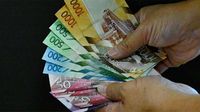
US dollars held against a currency exchange rate board at a forex bureau in Nairobi. FILE PHOTO | NMG
Summary
- Bank treasuries show that lenders are selling dollars at between Sh113 and Sh116 per dollar while Central Bank of Kenya (CBK) places the trade at an average of Sh110.07.
- A dealer in a local bank says as a result of the divergence, banks are opting to hold on to their dollars, concerned that they would come under scrutiny when they sell at the higher prevailing price.
Confusion has hit banks over the shilling’s exchange rate against the dollar, with the lenders now buying and selling well above the printed official rate when buying hard currency from one another.
Bank treasuries show that lenders are selling dollars at between Sh113 and Sh116 per dollar while Central Bank of Kenya (CBK) places the trade at an average of Sh110.07.
Analysts at South African lender Standard Bank, which trades in Kenya as Stanbic, pointed to the risk of the market developing a dual exchange rate, one being the official CBK rate for the shilling-dollar pair and the other being the actual or executable forex interbank rate.
They added that between the end of June and September, there were certain banks that were clearly confused where the price of the dollar-shilling actually was.
“But the conundrum for them was whether to trade at the executable foreign exchange interbank rate that was higher than the official CBK rate or simply stop supplying dollars to the market, owing to concerns of reprisal from the apex bank,” said Standard Bank told its clients in a note dated November 30.
“Due to this divergence in screen and foreign exchange interbank rates, admittedly price discovery has been very cumbersome.”
A dealer in a local bank who spoke to the Business Daily on condition of anonymity said as a result of the divergence, banks are opting to hold on to their dollars, concerned that they would come under scrutiny when they sell at the higher prevailing price.
They are also concerned that they might not be able to replenish their stock of dollars from the cautious market, with the net effect being an appearance of low dollar liquidity in the market.
Standard Bank added that the CBK has also not been actively selling dollars in the past one month, and has instead relied on mopping up shillings to keep a lid on exchange rate volatility.
“For dollar selling to the market to be effective, arguably the CBK would have to supply dollars at the executable forex interbank rate. However, they probably don’t want to do this as they don’t acknowledge this rate divergence and perhaps somewhat wouldn’t want to legitimise it,” said Standard Bank.
“However, while the issue predominantly remains an foreign exchange pricing one, if these issues are not addressed, the pricing issue will decimate market making abilities and ultimately morph into a widespread forex liquidity problem.”







No comments :
Post a Comment